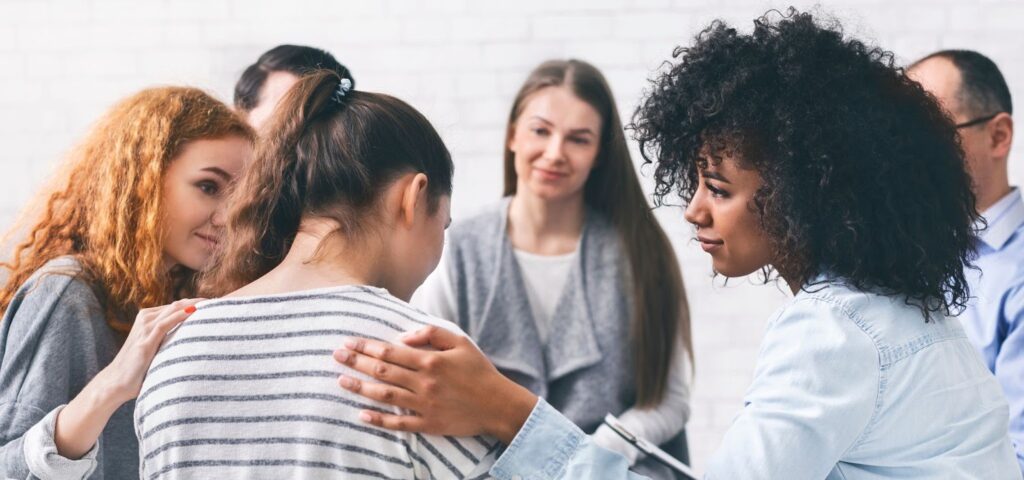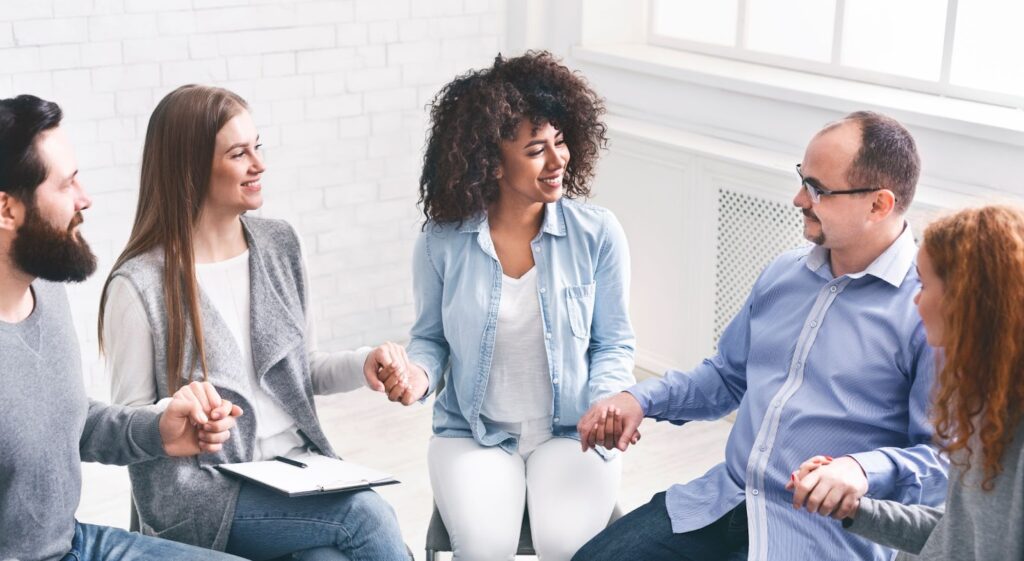Group therapy is an effective form of treatment for many mental health issues.
But there can be challenges when it comes to learning how to build trust in group therapy.
Trust in a group environment is essential in order to make sure the therapeutic process works.
And it’s important that all participants feel comfortable participating and sharing their experiences.
But how do you go about creating an atmosphere of trust in a group setting?
Group Therapy Basics
Group therapy is an effective way for people to explore their mental health issues and connect with others who are going through similar experiences.
It can also be a great way to learn coping skills and strategies.
In this article we are focusing on process groups though some of the points apply to skills groups as well.
This is of course in addition to its many other potential benefits.
Understanding the basics of how to build trust in group therapy is key to having successful sessions.
Trust within a group setting can be developed over time by creating an environment where members feel safe and comfortable sharing their thoughts, feelings, and experiences without fear of judgment or ridicule.
Each member should be given the chance to express themselves openly while also respecting each other’s privacy.
Acknowledging individual contributions as well as showing mutual respect and understanding encourages members to feel supported in their journey towards healing.

Benefits of Building Trust
Building trust is essential for successful group therapy.
Strong, trusting relationships between members of the group are necessary to create a safe, supportive environment that enables open communication and honest exploration of feelings and experiences.
Trust within a therapeutic setting helps individuals feel secure enough to confront their issues in a non-judgmental atmosphere.
Creating an open space for all members to be heard and express themselves without fear of criticism or judgment is paramount for fostering trust within the group dynamic.
Setting clear expectations regarding confidentiality, respect, and safety are also part of creating an environment where everyone feels secure enough to share their thoughts with one another.

How to Create a Safe Space
Creating a safe space for group therapy can be essential for fostering trust and healing.
In order to create an effective therapeutic environment, it is important to consider how to ensure physical safety as well psychological safety, comfort and respect.
Physical safety encompasses the physical boundaries of a space that protect against any potential risks such as violence or other harm.
Ensuring there are no drugs or alcohol present, having a system in place for people to arrive and leave the space safely and providing measures like first aid supplies can help maintain physical security.
Psychological safety refers to the feeling of being respected, accepted and supported.
This can be achieved by establishing clear boundaries and expectations around behavior, creating rules that everyone will follow such as confidentiality agreements, and setting up an environment where participants feel comfortable discussing their thoughts without judgment or fear of repercussions.

Encouraging Open Communication
Open communication is essential for trust to form in group therapy.
Learning the proper techniques to encourage open communication and foster an environment that promotes trust is key.
Group therapy requires vulnerability on the part of participants, so it is important that they feel comfortable being honest with each other and their therapist.
Creating an atmosphere that emphasizes safety, respect, acceptance, authenticity, confidentiality and empathy can help build trust within the group by allowing members to feel more at ease discussing sensitive topics.

Using Ground Rules and Structures
Using ground rules and structures can be an effective way to build trust in group therapy.
Having structure is key to creating a safe, secure environment within the group where participants feel comfortable expressing themselves.
Structures give everyone a framework on which to build their discussions, allowing each person to have their own voice within the conversation.
A well-crafted set of ground rules and structured activities can help create a sense of safety and connectedness among participants.
This will allow them to open up more freely without fear of judgment or criticism from others in the group.
Additionally, it allows members to know what is expected of them and helps ensure that conversations stay focused on topics relevant to the therapy session rather than drifting off topic or becoming heated arguments between individuals.

Managing Difficult Conversations
Managing difficult conversations is essential to successful group therapy.
Figuring out how to build trust in group therapy can be particularly challenging and must include considerations of the individual members’ needs, boundaries, and expectations.
It is important for therapists to create an atmosphere of safety and support so that individuals feel comfortable engaging in deep conversations with their peers.
To encourage trust-building in group therapy sessions, it is essential to remind participants that whatever they share remains confidential within the confines of the therapeutic space.
Additionally, therapists should provide clear guidelines around how members can interact respectfully with each other while having difficult conversations or disagreements.
This could include outlining expectations related to active listening or providing positive reinforcement when participants successfully engage in meaningful dialogue without becoming defensive or attacking other members’ perspectives.

Final Reflections
Final reflections can be an important part of group therapy.
Reflections provide participants with the opportunity to reflect on how their experiences have impacted them, as well as the other members of the group.
This can be especially useful in building trust among members and allowing for a better understanding between all individuals involved.
When it comes to how to build trust in group therapy, listening is key.
The therapist should actively listen and acknowledge what each person has said without judgment or interruption.
It’s also important for members of the group to feel comfortable expressing themselves without fear or doubt about what others may think about them; this means emphasizing respect, open-mindedness, and acceptance within the group’s dynamics.

Leveraging Group Dynamics
This type of therapeutic approach works by having members of the group interact with each other in order to build interpersonal relationships and provide support for one another.
Leveraging group dynamics can help create an environment where individuals feel comfortable enough to share their thoughts, feelings, and experiences with others in the group which leads to increased trust.
In order for effective group work to take place, it is essential for counselors or therapists leading the session to foster healthy relationships within the group.
This includes creating a safe space where individuals can express themselves without fear of judgment or criticism from others.
It also involves encouraging open dialogue by asking questions that allow members of the group to reflect on their own experiences and learn from those around them.

Conclusion
Learning how to build trust in group therapy is an important step to help promote a safe and secure environment.
It starts with the therapist establishing boundaries, creating a trusting atmosphere, and building relationships between members of the group.
The therapist should also practice active listening skills, providing effective feedback, and maintaining confidentiality.
Lastly, it is essential for the therapist to provide consistent support and guidance throughout the entire process of developing trust within the group.






